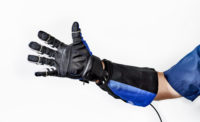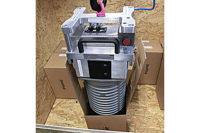For many years, plant managers told assemblers to “work smarter, not harder” without providing them the proper tools to achieve this goal. This was especially challenging for workers who had to lift heavy objects around their workstations. Today, however, they can “lift smarter and work easier” thanks to a wide variety of state-of-the-art cranes, hoists, intelligent assist devices and work positioners.
Assemblers at one Turkish automotive plant very much welcome these tools to ease and quicken the installation of front and rear suspensions for two different auto models. Initially, each suspension was handled and installed with a pneumatic loader. But its slow speed, lack of control and difficulty adapting to several suspension weights slowed production considerably—preventing workers from meeting the required installation rate of 50 suspensions per hour.
To solve the problem, managers replaced the pneumatic loader with two Easy Arm lifting devices made by Gorbel Inc. Both devices are 10 feet high, have a 10-foot reach and feature G-Force technology that offers more control, greater speed and easier lifting than the loader. Lift capacity is generated by a servo-controlled actuator at the top of the device. A coiled air line connects the actuator to a handle that maneuvers the part.
One Easy Arm is equipped with a Q330 actuator (330-pound lift capacity) that lifts and moves 220-pound front suspensions. The other device has a Q165 actuator, and it handles 165-pound rear suspensions.
Just as happy with the Easy Arm are assemblers and managers at the Oerlikon Fairfield plant in Lafayette, IN. The company makes Torque Hub gears and drives for OEMs worldwide.
Each product weighs 50 to 80 pounds when assembled. Until recently, assemblers at one work cell manually moved each part to a worktable from nearby stacks, rotated and flipped the increasingly heavier assembly, and moved the finished product to a storage area.
Facility engineering supervisor Anthony Schenk says this approach resulted in each worker assembling only six or seven units per shift, about 20 per day over three shifts. More importantly, the manual lifting produced excessive wear and tear on the worker day after day.
Two years ago, the company installed Easy Arms to improve worker ergonomics and increase productivity. A handle with end-of-arm tooling enables the assembler to easily retrieve parts, and rotate and flip the assembly. As for productivity, Schenk says a worker now assembles 20 units per shift—a 300- percent increase.
Crane Considerations
Assemblers primarily use four types of cranes. Jib cranes feature a horizontal member (jib) that supports a lift device (hoist, air balancer, intelligent assist device). It can be freestanding or fixed to either a wall or floor-mounted pillar. A gantry (frame) crane spans the work area. It is mobile and features a trolley or fixed machinery housing that runs horizontally along I-beams or an enclosed track. The lift device attaches to the trolley or housing.
Workstation cranes are similar to gantry cranes, in that they span the work area, but differ in that they are freestanding or floor- or ceiling-mounted. Overhead (or bridge) cranes feature a moveable bridge that travels along an overhead runway structure incorporated into the building’s ceiling. A variation is the underhung crane, where the runway beam is often suspended from the roof to eliminate columns and increase floor space.
Manufacturers must consider several factors to select the best crane for an application. These include the size of the object being lifted; lifting height and frequency; velocity, acceleration and travel distance of the load; overall height, clearance and usable space; and the distance of the object from the assembler.
Manufacturers in various industries frequently use WSJ360 and WSJ200 jib cranes for assembly because they offer a lifting capacity of 1,000 pounds and a work span of 20 feet. The WSJ360-F is a free-standing model that provides 360 degrees of rotation. Model WSJ200 is a ceiling-mounted version with the same capabilities.
Konecranes’ XM jib cranes feature an adjustable console bearing that allows easy horizontal beam adjustment during and after the commissioning process (done to ensure compliance with OSHA safety guidelines). Chuck Snook, sales manager—workstation lifting systems for Konecranes USA, says this feature minimizes unintended beam and trolley movements when the crane is loaded. More importantly, it eliminates the need to disassemble the crane due to erratic self-movement of the beam.
These cranes have a 2-ton lifting capacity and a lightweight, hollow-profile beam that reduces stresses on building structures. Low-friction wheels increase efficiency. The main disconnect switch is located on a column or mounts on a wall.
The company also makes portable custom gantry cranes that are easy to assemble and disassemble for relocation. They are available with lift capacities from 1 to 5 tons and spans from 2.5 to 5 meters. Automotive, aerospace, truck and marine-equipment manufacturers like the cranes because of their speed, durability, load control and placement accuracy.
“Workstation cranes are used extensively to lift parts or assemblies that weigh from 500 pounds to 1 ton,” claims Dave Comiono, vice president and co-founder of EMH Inc. “Often, manufacturers will install these cranes throughout the plant in assembly and welding stations.”
AL Systems workstation cranes feature aluminum rails with T-slots that allow for quick installation and an almost unlimited number of configurations (ceiling mounted or freestyle). Splices between lengths of rail are bolted together without gaps to ensure smooth trolley movement.
Comiono says lawn-mower manufacturers prefer the cranes when moving or assembling engines. He also says Medina, OH-based Rico Manufacturing uses the cranes to build its explosion-proof lift trucks for natural-gas exploration and military applications.
Another aluminum workstation crane, the XA, offers low rolling resistance and dead weight that allows easy load handling with push-pull trolleys rather than motorized drives. Snook says the crane requires a force of only 1 percent to 1.5 percent of object weight to initiate movement, compared to 4 percent to 5 percent for steel rails.
The EZ workstation crane features steel beams in lengths of 5 to 30 feet, and can be made 10 to 14 feet high and 10 to 125 feet long. Lift capacity ranges from 275 to 2,000 pounds. According to Michael Keim, ergonomics business leader for Ingersoll Rand Co., Tier 1 auto suppliers like that the crane is modular and easy to install. It features a bridge that articulates up to 19 degrees in either direction to lower rolling resistance to 1 percent.
American Crane and Equipment Corp. specializes in custom overhead cranes having capacities from 1 to 1,000 tons. One of its most complex projects was the design, manufacture and installation of an 80-ton-capacity underhung crane system at the Boeing 787 final assembly building in North Charleston, SC.
Completed in spring 2011, the system features 14 underhang bridges that interlock so trolleys can be transferred from one bridge to another throughout the system, notes Karen Norheim, vice president of marketing and IT at American Crane. The building measures 460 by 1,000 feet and is designed without columns to increase floor space and provide workers 100 percent accessibility to the assembly floor area from the crane system.
“It features three trolleys that operators use to lift airplane components and position them for final assembly,” says Norheim. “Each trolley can be rotated ±180 degrees and features two single-girder beams that each support two 10-ton hoists. In addition, each hoist has its own trolley that allows for movement in all directions.”
Up, Down and All Around
Every crane requires a lift device to raise, turn or transport a heavy object. For centuries, a hoist was the only option for workers. That changed in the 1960s with the introduction of air balancers. The landscape changed again about 10 years ago with the introduction of intelligent assist devices.
“Hoist control has improved considerably in recent years with the introduction of variable frequency drives,” notes Comiono. “Workers can operate hoists at many speeds now, compared to the one or two speeds possible with contactor-circuit-based controls.”
The SU series of electric wire rope hoists feature a variable frequency drive, along with a swivel trolley that moves easily along curved girders. Comiono says manufacturers use these hoists when it’s necessary to move a part from one bay to another along a crooked path. Lift capacity ranges from 2 to 13.75 tons.
A couple years ago, the CLK pneumatic hoist series was introduced. Its connecting hook at the top can operate with 360-degree swivel motion or be locked into place in 90-degree increments. The 275-pound models have a lifting speed of 43 fpm, the 550-pound models a speed of 32 fpm. Enhanced motor control and a brake release increase precision.
An air balancer prevents overloading or jerky motions because it is powered by air pressure rather than electricity. This device runs quietly and smoothly lifts small, large and fragile items.
Four models encompass the Zimmerman balancer series, with capacities from 150 to 2,000 pounds. The B unit offers no extra control, while model ZA has pendant control so it can be used for assembly applications. The servo control unit (BA) maintains constant tension through a full range of motion. Also available is model EA, which offers balancing in three modes: high, low or no load control.
The ATB balancer moves items weighing up to 775 pounds at speeds up to 79 inches per second. Control options include single load for fixed weights, dual and triple load for constant weights and manual touch lever with load weight compensation. Mechanical, pneumatic, vacuum and magnetic grab devices are available for grabbing/bracing, holding and releasing the load.
Intelligent assist devices, like the Easy Arm, are growing in popularity, according to Mark Grandusky, G-Force product sales manager for Gorbel Inc. These devices come with Q or iQ series actuators that lift loads from 165 to 330 pounds at speeds up to 200 fpm. The iQ series also allows an assembler to control one G-Force or Easy Arm unit with two handles or two G-Force units with one handle. This feature is for applications when tooling requires more than one point of control.
In float mode, the Easy Are handle allows an operator to guide an object precisely with both hands. On the handle’s backside is a photosensor that prevents load movement unless the worker grabs the handle and breaks the sensor beam. An LCD panel displays load weight and enables easy control of acceleration.
Another intelligent device is the QL R 25i fromBinair Quick-Lift Systems AB. Its maximum lift capacity is 275 pounds. To engage up and down motion, the device requires a force equivalent to only 0.7 ounce. Motion stops immediately when the assembler lets go of the handle or object.
Not all lift-assist equipment requires a crane. Work positioners feature a platform that raises, lowers and rotates parts or assemblies for easy access.
Earl Hagman, president of Ergotech Inc., says a Tier 1 supplier uses the Ergo Control positioner to assemble transmissions for an under-construction helicopter planned to become the United States’ largest when finished. The transmissions can weigh up to 6,000 pounds, including tooling. They power the helicopter’s main and tail rotors.
Ergo Control features a three-axis L-shaped arm that enables an assembler to always comfortably reach any area of the part being assembled. The arm handles heavy, large and awkwardly shaped objects, and can even turn them upside down.
Verti-Lift Inc.’s positioners offer 1- and 2-ton lift capacities and feature 360-degree manual turntables that measure 3 or 4 feet square. The heavy-duty tables can be raised to 34 inches and lowered to 10 inches.
ASSEMBLY ONLINE
For more information on lift-assist devices, visit www.assemblymag.com to read these articles:
Ergonomic Lift-Assist Device Improves Worker Safety, Productivity.







